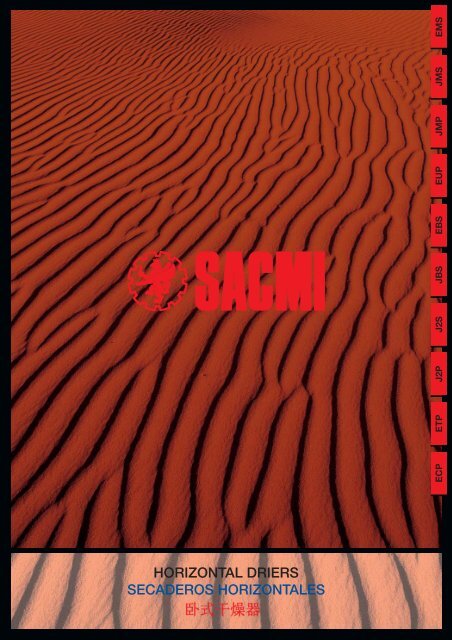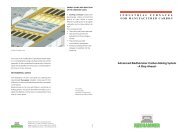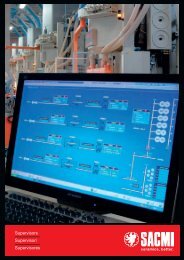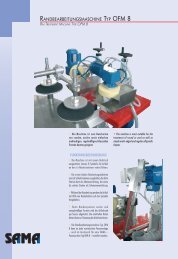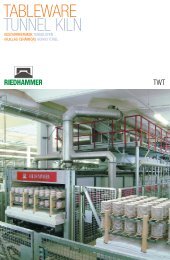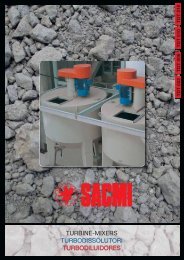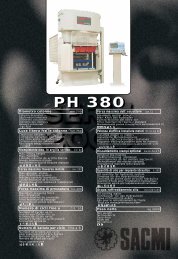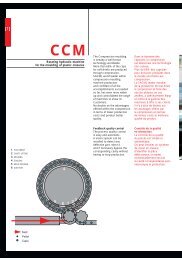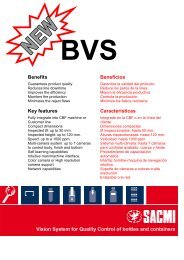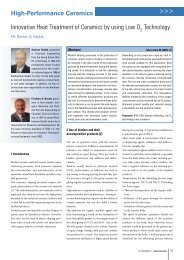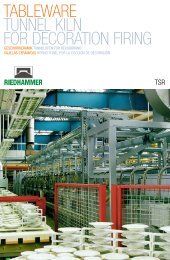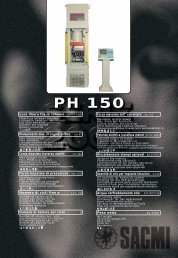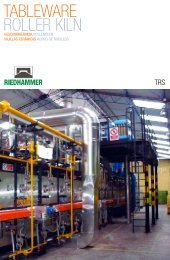HORIZONTAL DRIERS SECADEROS HORIZONTALES - Sacmi Forni
HORIZONTAL DRIERS SECADEROS HORIZONTALES - Sacmi Forni
HORIZONTAL DRIERS SECADEROS HORIZONTALES - Sacmi Forni
Create successful ePaper yourself
Turn your PDF publications into a flip-book with our unique Google optimized e-Paper software.
ECP<br />
ETP<br />
J2P<br />
J2S<br />
JBS<br />
EBS<br />
EUP<br />
JMP<br />
JMS<br />
EMS<br />
<strong>HORIZONTAL</strong> <strong>DRIERS</strong><br />
<strong>SECADEROS</strong> <strong>HORIZONTAL</strong>ES
<strong>HORIZONTAL</strong> <strong>DRIERS</strong><br />
Easy to use<br />
A medida<br />
del hombre<br />
Horizontal driers, perfectly<br />
compatible with the ceramics<br />
industry needs, combine<br />
performance, which has<br />
always been outstanding<br />
in <strong>Sacmi</strong>’s machines,<br />
with updated operation.<br />
<strong>Sacmi</strong> has focused a great<br />
deal of attention on improving<br />
the man-machine relationship<br />
and on following the Kioto<br />
directives when designing<br />
these machines. Adjustments<br />
have been simplified,<br />
maintenance times have been<br />
reduced, machine efficiency<br />
has been improved and<br />
consumption rates have<br />
been reduced.<br />
Los secaderos horizontales,<br />
en línea con las actuales<br />
exigencias del mundo<br />
cerámico, conjugan los<br />
resultados que desde siempre<br />
distinguen a las máquinas<br />
<strong>Sacmi</strong> con una funcionalidad<br />
renovada.<br />
Atenta, durante la fase<br />
de proyecto, a la mejora<br />
de la relación hombre-máquina<br />
y a las directivas del protocolo<br />
de Kyoto, <strong>Sacmi</strong> ha<br />
simplificado las regulaciones,<br />
reducido los tiempos<br />
relacionados con el<br />
mantenimiento, aumentado<br />
la eficiencia de las máquina<br />
y disminuido los consumos.
<strong>HORIZONTAL</strong> <strong>DRIERS</strong>
Benefits<br />
Prerrogativas<br />
<strong>Sacmi</strong> horizontal driers offer<br />
the following special features:<br />
- external air circulation piping<br />
on all machines<br />
- separation of layers in<br />
multi-layer machines.<br />
With external piping the air<br />
flow follows a more linear,<br />
less twisted route than would<br />
be provided by intra-wall<br />
piping. There is a significant<br />
reduction of load loss that<br />
results in easier adjustment of<br />
the air blown above and below<br />
each layer. As a result, less<br />
powerful fans are being used.<br />
Plus, shorter steps can be<br />
made between rollers<br />
in smaller sizes.<br />
This system provides more<br />
even heat distribution and<br />
guarantees uniform temperature<br />
for the entire load.<br />
The temperature differences<br />
between tiles in different parts<br />
of the drier vary by a maximum<br />
of just 5°C. This value is<br />
significantly lower than the<br />
temperature recorded in<br />
multi-layer driers in one model.<br />
In addition, tile breakage<br />
is limited to just one layer and<br />
is unable to spread to those<br />
underneath. If necessary,<br />
a special construction feature<br />
allows the rollers on the oblique<br />
axis to be removed without the<br />
need for a lateral gap that is<br />
longer than the actual roller.<br />
The side access doors provide<br />
easy access to the various<br />
layers.<br />
Las peculiaridades de los<br />
secaderos horizontales <strong>Sacmi</strong><br />
son:<br />
- tuberías para la circulación<br />
del aire, externas a la máquina<br />
- separación de los planos en<br />
las máquinas multicanal.<br />
La colocación de las tuberías<br />
en el exterior de la máquina<br />
optimiza la circulación del aire.<br />
De hecho, el flujo de aire<br />
realiza un recorrido más lineal<br />
y menos tortuoso del que<br />
cumpliría si las tuberías se<br />
encontrarán en el interior de<br />
la pared. Se reducen<br />
sensiblemente las pérdidas de<br />
carga, se facilita la regulación<br />
del soplado por encima<br />
y por debajo de cada plano,<br />
se adoptan ventiladores<br />
de potencia menor y, ante<br />
pequeños formatos, es posible<br />
realizar pasos reducidos entre<br />
los rodillos.
Con planos separados<br />
se obtiene una distribución<br />
del calor homogénea y una<br />
uniformidad de temperatura en<br />
toda la carga. La diferencia de<br />
temperatura entre los azulejos<br />
en diferentes posiciones se<br />
encuentra típicamente<br />
alrededor de los 5º C, valor<br />
netamente inferior al registrado<br />
en secaderos con planos<br />
múltiples de ambiente único.<br />
Asimismo, eventuales roturas<br />
de azulejos no conllevan<br />
consecuencias al material de<br />
los planos inferiores. En caso<br />
de necesidad, una mejora<br />
constructiva particular permite<br />
la extracción de los rodillos a<br />
los largo de un eje oblicuo, sin<br />
que sea necesario disponer de<br />
un espacio lateral superior a la<br />
longitud del propio rodillo. Las<br />
puertas de acceso laterales,<br />
permiten acceder fácilmente<br />
a los diferentes planos.<br />
<strong>HORIZONTAL</strong> <strong>DRIERS</strong>
Process air circulation<br />
Circulación del aire de proceso<br />
In multi-layer driers, the air is<br />
blown in and out of each layer,<br />
above and below the tile<br />
providing significant<br />
advantages in terms of<br />
consistent temperatures.<br />
The elements used to deliver<br />
air for drying the tiles were<br />
designed using the most<br />
sophisticated fluid dynamic<br />
calculation methods.<br />
This provided maximum<br />
efficiency for convective heat<br />
exchange and reduced intake<br />
of air to be heated for<br />
re-circulation. The result is<br />
significant savings in energy<br />
costs.<br />
By re-circulating as much<br />
heated air as possible, the<br />
introduction of air to be heated<br />
is reduced to an absolute<br />
minimum with significant<br />
energy savings.<br />
En los secaderos con planos<br />
múltiples, el aire es soplado<br />
y aspirado en cada plano,<br />
por encima y por debajo de los<br />
azulejos, aportando evidentes<br />
ventajas en términos de<br />
homogeneidad de temperatura.<br />
El proyecto de los elementos<br />
predispuestos para el<br />
suministro del aire de<br />
tratamiento, ha sido efectuado<br />
con la ayuda de los métodos<br />
de cálculo fluidodinámico<br />
más sofisticados.<br />
Esto ha permitido un aumento<br />
de la eficiencia de los<br />
intercambios de calor<br />
convectivos y la reducción de la<br />
emisión de aire de renovación,<br />
que se precalentará con ahorros<br />
energéticos significativos.<br />
Manteniendo bajo recirculación<br />
la máxima cantidad posible<br />
de aire caliente, se reduce al<br />
mínimo, la emisión de aire de<br />
renovación por precalentar con<br />
ahorros energéticos significativos.<br />
HIGH AIR-PRODUCT<br />
EXCHANGE<br />
EFFICIENCY<br />
ALTA EFICIENCIA<br />
DE INTERCAMBIO<br />
AIRE - PRODUCTO<br />
LOW<br />
WORKING<br />
TEMPERATURE<br />
BAJA<br />
TERMPERATURA<br />
DE FUNCIONAMIENTO<br />
LOW RATE<br />
OF NEW AIR<br />
INTRODUCTION<br />
BAJOS CAUDALES<br />
ASPIRADOS COMO<br />
AIRE DE<br />
RENOVACIÓN<br />
LOW RATE<br />
OF LOSS<br />
FROM THE STACK<br />
BAJAS<br />
PÉRDIDAS<br />
POR LA CHIMENEA<br />
LOW<br />
ENERGY<br />
CONSUMPTION<br />
BAJOS<br />
CONSUMOS<br />
➪ ➪ ➪<br />
ENERGÉTICOS<br />
In addition, hot air from<br />
the cooling area of the kiln<br />
can be used to lower specific<br />
temperature consumption<br />
even more.<br />
Es posible, asimismo,<br />
la utilización de aire caliente<br />
proveniente de la zona<br />
de enfriamiento del horno<br />
con un ulterior descenso<br />
de los consumos térmicos<br />
específicos.
Drive<br />
Transmisión del movimiento<br />
<strong>HORIZONTAL</strong> <strong>DRIERS</strong><br />
The rollers are driven by pairs<br />
of helical toothed gears sealed<br />
in a housing with oil-bath type<br />
lubrication.<br />
This makes the machines<br />
extremely reliable and<br />
virtually maintenance-free.<br />
Each drier zone has its own<br />
drive regulation system and<br />
is fully independent from<br />
a thermo-hygrometric<br />
standpoint.<br />
The rollers are made<br />
of weld-free carbon steel to<br />
ensure maximum order and<br />
alignment of the exiting tiles<br />
(condition necessary to<br />
guarantee proper operation<br />
of the unloading machine);<br />
rollers are made according to<br />
extremely strict straightness<br />
tolerances.<br />
En los secaderos horizontales,<br />
la transmisión del movimiento<br />
a los rodillos se produce<br />
mediante pares de engranajes<br />
con dientes helicoidales en<br />
cárter cerrado, con lubricación<br />
por baño de aceite. Esto<br />
permite que todas las máquinas<br />
sean extremadamente fiables<br />
y prácticamente exentas<br />
de mantenimiento.<br />
Cada zona del secadero posee<br />
una regulación de los<br />
dispositivos de arrastre propia<br />
y es independiente desde el<br />
punto de vista termohigro<br />
métrico. Los rodillos están<br />
realizados con acero al carbono<br />
y, para obtener el máximo<br />
orden y alineación de las<br />
piezas a la salida (condición<br />
necesaria para un buen<br />
funcionamiento de la máquina<br />
de descarga), se suministran<br />
con tolerancias de rectitud<br />
muy pequeñas.
Control Panel<br />
Cuadro de control<br />
The control panel monitors<br />
drier operation at all times.<br />
The most important values<br />
(temperature and speed) are<br />
measured and displayed with<br />
the diagnostic and fault<br />
messages.<br />
In the single-channel EMS,<br />
JMS and JMP driers and the<br />
twin-channel EBS, JBS, J2S<br />
and J2P installed in-line with<br />
the respective kilns, the drier<br />
control is integrated into the<br />
kiln control.<br />
If these driers are separated<br />
from the kilns, a specific<br />
control panel is provided for<br />
their control.<br />
This control panel is provided<br />
with a PLC and operator<br />
interface panel that allows<br />
the operating parameters of<br />
the drier and loading/unloading<br />
machines to be changed.<br />
The multi-channel ETP and<br />
ECP drier control panels are<br />
equipped with a PLC, a control<br />
PC (EFP300) and controls to<br />
govern the loading/unloading<br />
machines.<br />
The computer also allows<br />
the user to display and adjust<br />
the temperature in the areas<br />
provided, display cycle times,<br />
identify gaps in the production<br />
flow, synchronize conveying<br />
speed with the number<br />
of press cycles and save up<br />
to 90 recipes.<br />
En el cuadro de mando es<br />
posible controlar, en cada<br />
momento, el funcionamiento<br />
del secadero: los valores más<br />
significativos (temperaturas<br />
y velocidad) se miden y se<br />
visualizan junto con los<br />
mensajes de diagnóstico<br />
y alarma.<br />
En el caso de los secaderos<br />
monocanal EMS, JMS y JMP,<br />
de los bicanal EBS, JBS, J2S y<br />
J2P y de los EUP y EMS, que<br />
están instalados en línea con<br />
los respectivos hornos, el<br />
control del secadero queda<br />
integrado en el control del<br />
horno. En caso que estos<br />
secaderos estén separados del<br />
horno se ha previsto un cuadro<br />
eléctrico dedicado para su<br />
control. Dicho cuadro eléctrico<br />
está equipado con PLC y panel<br />
de interfaz operador que
permite variar los parámetros<br />
de funcionamiento del secadero<br />
y de las máquinas de carga /<br />
descarga.<br />
Los secaderos multicanal ETP<br />
y ECP están equipados con un<br />
cuadro eléctrico dotado de<br />
PLC, PC de supervisión<br />
(EFP300) y accionamientos<br />
para la gestión de las<br />
máquinas de carga / descarga.<br />
Desde el PC es posible<br />
visualizar y regular la<br />
temperatura de las zonas<br />
previstas, monitorizar la<br />
duración del ciclo, visualizar<br />
la presencia y la posición<br />
de eventuales vacíos de<br />
producción, sincronizar la<br />
velocidad de los dispositivos<br />
de arrastre de transporte con<br />
el número de ciclos de la<br />
prensa y memorizar hasta 90<br />
recetas.<br />
<strong>HORIZONTAL</strong> <strong>DRIERS</strong>
Single-channel Driers<br />
Secaderos monocanal<br />
The EMS, EUP, JMS and JMP<br />
driers can be used for drying<br />
biscuit tiles for dual-firing and<br />
reducing residual water before<br />
firing, in accordance with the<br />
kiln.<br />
The EMS and EUP models may<br />
also be used for drying tiles to<br />
be sent to the glazing unit.<br />
The driers can sufficiently<br />
control the exiting tile<br />
temperatures using the<br />
specially designed system.<br />
The single-channel driers are<br />
made by a variable number<br />
of independent thermohygrometric<br />
modules.<br />
The burner and electric<br />
systems comply with European<br />
standards.<br />
EMS<br />
In the first section of the EMS,<br />
where ventilation is parallel to<br />
the tile faces and follows the<br />
direction of product flow, air is<br />
emitted by transverse ducts<br />
and directed by internal air<br />
distribution deflectors. In the<br />
second section heat treatment<br />
involves a counter-flow and,<br />
if the tiles are to be sent on to<br />
the glazing unit, there is also a<br />
small centrifugal fan to control<br />
the material exiting the drier.<br />
The EMS driers are equipped<br />
with one or more air flow<br />
burners with modulating control.<br />
EUP<br />
The EUP is divided into a series<br />
of adjustment zones, which<br />
vary in length from 4.2 to 6.3 m.<br />
In each zone the hot air is<br />
re-circulated by a centrifugal<br />
fan, while the heat itself is<br />
produced by a burner inserted<br />
in the circuit.<br />
Hot air is blown into the drier<br />
via tubes placed above and<br />
below the tile conveyor layer,<br />
thus providing homogeneous<br />
drying. With the suitable<br />
equipment, this type of drier<br />
can be used to feed the glazing<br />
unit as well.<br />
JMS and JMP<br />
The JMS version and the<br />
panelled JMP variant have<br />
been designed for fast removal<br />
of water from materials exiting<br />
presses, glazing units or storage<br />
areas. Heat is distributed evenly<br />
by small, high-speed burners<br />
and special steel tubes.<br />
Combustion gases exit through<br />
small holes in the tubes, thus<br />
summing both the convection<br />
and radiation effects.<br />
The JMS and JMP driers are<br />
generally linked with the FMS<br />
and FMP kilns. However,<br />
instead of using re-circulation<br />
fans like the EMS, the JMS<br />
features a fan for the<br />
combustion air and another<br />
for fume exhaustion.<br />
In this manner, the drier<br />
operates independently of<br />
the kiln to which it is linked.
<strong>HORIZONTAL</strong> <strong>DRIERS</strong><br />
Los secaderos EMS, EUP, JMS<br />
y JMP pueden utilizarse para<br />
el secado del bizcocho para<br />
bicocción y, en línea con<br />
el horno, para la reducción<br />
del agua residual antes<br />
de la cocción.<br />
Los modelos EMS y EUP<br />
pueden utilizarse, asimismo,<br />
para el secado de productos<br />
que deben ser esmaltados<br />
pudiendo controlar<br />
adecuadamente, mediante<br />
un oportuno sistema, la<br />
temperatura de los azulejos<br />
que salen de la máquina.<br />
Los secaderos monocanal<br />
están formados por un número<br />
variable de módulos<br />
independientes desde el punto<br />
de vista termohigrométrico.<br />
La instalación térmica y<br />
la eléctrica cumplen con<br />
las normativas europeas.<br />
EMS<br />
En la primera parte de los EMS,<br />
la ventilación es paralela a las<br />
caras de las piezas y se<br />
produce en equicorriente<br />
mediante cajones transversales<br />
y deflectores internos de<br />
distribución del aire. En la<br />
segunda parte, el tratamiento<br />
térmico se efectúa a<br />
contracorriente y, si el producto<br />
está destinado a la<br />
esmaltadora, está presente<br />
también un ventilador centrífugo<br />
para el control de la<br />
temperatura del material<br />
a la salida.<br />
Los EMS están equipados con<br />
uno o más quemadores de gas<br />
en vena de aire con regulación<br />
modulante.<br />
EUP<br />
Está dividido por zonas de<br />
regulación cuya longitud varía<br />
de 4,2 a 6,3 metros.<br />
En cada zona, la recirculación<br />
del aire caliente está<br />
garantizada por un ventilador<br />
centrífugo mientras que<br />
el calentamiento se confía<br />
a un quemador introducido en<br />
el circuito.<br />
El aire caliente, soplado en el<br />
interior del secadero mediante<br />
tuberías situadas encima y<br />
debajo del plano de los rodillos,<br />
permite un secado homogéneo.<br />
Este tipo de secadero, con<br />
oportuno equipamiento, puede<br />
utilizarse incluso para alimentar<br />
la esmaltadora.<br />
JMS y JMP<br />
Eliminan rápidamente el agua<br />
contenida en el material<br />
proveniente de la prensa,<br />
de la esmaltadora o del área<br />
de almacenamiento. El calor es<br />
distribuido uniformemente<br />
mediante pequeños que<br />
madores de alta velocidad,<br />
a través de tuberías especiales<br />
de acero inoxidable.<br />
Los productos de la<br />
combustión, saliendo a través<br />
de pequeños orificios<br />
practicados en los tubos,<br />
suman el efecto de convección<br />
al de la irradiación.<br />
JMS y JMP están,<br />
generalmente, en línea<br />
respectivamente con<br />
los hornos FMS y FMP.<br />
A diferencia del EMS, en lugar<br />
de los ventiladores de<br />
recirculación, presentan<br />
un ventilador para el aire<br />
comburente y, en algunos<br />
casos, un ventilador dedicado<br />
a la expulsión de los humos.<br />
De este modo, el<br />
funcionamiento del secadero<br />
es independiente del horno<br />
al que está combinado.
<strong>HORIZONTAL</strong> <strong>DRIERS</strong><br />
Working load width<br />
Anchura útil de carga<br />
(mm)<br />
Pitch<br />
Paso<br />
(mm)<br />
Roller<br />
Rodillo<br />
Length<br />
Longitud<br />
(mm)<br />
Channel width<br />
Anchura canal<br />
(mm)<br />
1950<br />
2350<br />
2230<br />
2500<br />
2600<br />
2850<br />
2950<br />
2230<br />
2500<br />
2600<br />
2850<br />
2950<br />
2230<br />
2500<br />
2850<br />
2950<br />
1850<br />
2250<br />
1990<br />
2260<br />
2360<br />
2610<br />
2710<br />
1990<br />
2260<br />
2360<br />
2610<br />
2710<br />
2130<br />
2400<br />
2750<br />
2850<br />
37,5-47,7-72,4-91,1<br />
47,7-72,4-91,1<br />
67,7<br />
67,7<br />
67,7<br />
67,7<br />
70<br />
67,7<br />
67,7<br />
67,7<br />
67,7<br />
70<br />
91,1<br />
91,1<br />
91,1<br />
91,1<br />
25-31-31-40<br />
31-31-40<br />
45<br />
45<br />
52<br />
52<br />
54<br />
45<br />
45<br />
52<br />
52<br />
54<br />
40<br />
42<br />
42<br />
42<br />
8,4-25,2<br />
8,4-25,2<br />
8,4-18,9<br />
8,4-18,9<br />
8,4-18,9<br />
8,4-18,9<br />
8,4-18,9<br />
8,4-18,9<br />
8,4-18,9<br />
8,4-18,9<br />
8,4-18,9<br />
8,4-18,9<br />
8,4-25,2<br />
8,4-25,2<br />
8,4-25,2<br />
8,4-25,2<br />
EMS<br />
JMS<br />
JMP<br />
EUP
Two-channel driers<br />
Secadero bicanal<br />
These are generally linked to<br />
two-channel kilns so as to dry<br />
the biscuit completely or to<br />
eliminate residual water content<br />
from products that are to be<br />
glazed or stocked.<br />
The two, separate drier<br />
channels are connected to the<br />
corresponding kiln channels<br />
by a roller unit.<br />
Thanks to simplicity of<br />
regulation and great flexibility<br />
of the system, it is possible to<br />
dry two entirely different types<br />
of product in the two channels<br />
of the JBS, J2S and J2P<br />
models.<br />
On the EBS heat regulation<br />
is manual, while<br />
on the JBS it is automatic.<br />
All burner and electrical<br />
systems comply with European<br />
standards.<br />
EBS<br />
Every cell on the EBS features<br />
full thermo-hygrometric<br />
independence and has its own<br />
hot air generator and<br />
re-circulation fan.<br />
Each individual ventilation cell<br />
is 4.2 m long and air flow runs<br />
parallel to the product.<br />
Hot air is introduced via<br />
transverse ducts and is<br />
directed by internal deflector<br />
panels.<br />
JBS, J2S and J2P<br />
Good drying effectiveness is<br />
provided by an innovative,<br />
high-efficiency system based<br />
on small, high-speed burners<br />
and a system of stainless steel<br />
tubes that transmits most<br />
of the heat by radiation.<br />
Combustion air is supplied<br />
by the existing on-kiln system.<br />
The use of components made<br />
of ceramic and stainless steel<br />
greatly reduces the risk of<br />
the tiles being contaminated<br />
by metal particles.<br />
Control of individual channels<br />
is fully independent.
<strong>HORIZONTAL</strong> <strong>DRIERS</strong><br />
Generalmente combinados con<br />
hornos bicanal, se utilizan para<br />
secar el bizcocho o bien, para<br />
eliminar la humedad residual<br />
de los productos provenientes<br />
del esmaltado o de los<br />
almacenamientos. Los dos<br />
canales del secadero,<br />
separados entre sí, están<br />
conectados a<br />
los correspondientes canales<br />
del horno mediante<br />
un transportador de rodillos.<br />
Dada la simplicidad de<br />
regulación y la flexibilidad de la<br />
instalación, en los dos canales<br />
de los modelos JBS, J2S<br />
y J2P es posible tratar incluso<br />
materiales muy diferentes.<br />
En el EBS, la diferenciación<br />
de los tratamientos térmicos<br />
en los dos canales se produce<br />
con regulación manual, mientras<br />
que en el JBS, en el J2S y en<br />
el J2P es automática.<br />
Las instalaciones térmica<br />
y eléctrica están realizadas<br />
de acuerdo con las normativas<br />
europeas.<br />
EBS<br />
Cada celda, independiente<br />
desde el punto de vista<br />
termohigrométrico, cuenta con<br />
un generador de aire caliente<br />
propio y con un ventilador<br />
de recirculación.<br />
La celda de ventilación tiene<br />
una longitud de 4,2 metros y<br />
el flujo del aire es paralelo a las<br />
piezas. El aire de tratamiento<br />
viene suministrado mediante<br />
cajones transversales<br />
y deflectores de distribución<br />
internos a la máquina.<br />
JBS, J2S y J2P<br />
La eficacia del secado se<br />
confía a un sistema innovador<br />
y de alto rendimiento basado<br />
en pequeños quemadores de<br />
alta velocidad y a un sistema<br />
de tuberías de acero inoxidable<br />
que transmiten el calor,<br />
fundamentalmente,<br />
por irradiación.<br />
Los productos de la<br />
combustión salen a través de<br />
pequeños orificios practicados<br />
en los tubos y suman, a los<br />
efectos de convección,<br />
también los debidos a<br />
la irradiación.<br />
En los modelos J2S y J2P, los<br />
rodillos son de cerámica<br />
y no existen los tradicionales<br />
ventiladores de recirculación,<br />
sino solo un ventilador de<br />
expulsión del aire consumido.<br />
El aire comburente es extraído<br />
por la instalación existente<br />
en el horno.<br />
La utilización de componentes<br />
de cerámica y de acero<br />
inoxidable anula el riesgo<br />
de contaminar los productos<br />
con partículas metálicas.<br />
Los planos son gestionados<br />
de modo automático<br />
e independiente, los unos<br />
de los otros.
Channel width<br />
Anchura canal<br />
Working load width<br />
Anchura útil de carga<br />
Pitch<br />
Paso<br />
Roller<br />
Rodillo<br />
Length<br />
Longitud<br />
(mm)<br />
(mm)<br />
(mm)<br />
(mm)<br />
(mm)<br />
1950<br />
1850<br />
47,7-72,4-91,1<br />
31-31-40<br />
16,8-25,2<br />
2350<br />
2250<br />
72,4-91,1<br />
31-40<br />
16,8-25,2<br />
2230<br />
1990<br />
67,7<br />
45<br />
8,4-18,9<br />
JBS<br />
EBS<br />
2500<br />
2260<br />
67,7<br />
45<br />
8,4-18,9<br />
2600<br />
2360<br />
67,7<br />
52<br />
8,4-18,9<br />
J2P J2S<br />
2850<br />
2600<br />
2610<br />
2360<br />
67,7<br />
67,7<br />
52<br />
52<br />
8,4-18,9<br />
8,4-18,9<br />
2850<br />
2610<br />
67,7<br />
52<br />
8,4-18,9
Multi-channel Driers<br />
Secadero multicanal<br />
<strong>HORIZONTAL</strong> <strong>DRIERS</strong><br />
With load inlet widths ranging<br />
from 2.350 to 3.070 mm,<br />
the 3-channel ETP and<br />
5-channel ECP horizontal roller<br />
driers are generally used<br />
in plants with high output<br />
capacity.<br />
Designed to meet the<br />
space-saving needs common<br />
to many ceramic production<br />
plants, the driers in this range<br />
are generally used to feed<br />
glazing lines.<br />
Both versions have<br />
a modular structure:<br />
the standard configuration<br />
consists of four or more<br />
independent zones from a<br />
thermo-hygrometric standpoint.<br />
The various channels are fed<br />
by load/unload elevators.<br />
The metal roller drive system<br />
consists of a series of<br />
inverter-controlled gear motors,<br />
each of which moves the<br />
different layers (3 or 5) in each<br />
module.<br />
Rollers are driven by pairs of<br />
helical toothed gears; oil-bath<br />
type lubrication is used.<br />
Transfer roller units are placed<br />
at the two ends of the drier.<br />
They are powered by their own<br />
gear motors and accelerate<br />
the product into the drier and<br />
away from it in synchronization<br />
with the elevator<br />
loading/unloading operations<br />
that distribute the material<br />
on the layers.<br />
The burner and electrical<br />
systems, as well as all the<br />
safety devices comply with<br />
European standards.<br />
They include: side elevator<br />
guards, emergency stop cord<br />
on the drive side, access stairs<br />
and handrails in the regulation<br />
and/or maintenance zones,<br />
heat insulation and sound<br />
proofing, emergency production<br />
line shutdown buttons.<br />
Con una boca variable entre<br />
los 2350 y los 3070 mm.,<br />
los secaderos horizontales de<br />
rodillos con tres canales ETP y<br />
los de cinco canales ECP,<br />
se utilizan, generalmente,<br />
en instalaciones de gran<br />
capacidad de producción.<br />
Nacidos para responder a los<br />
problemas de espacio que<br />
surgen en muchas empresas<br />
de cerámica, esta gama<br />
de secaderos está destinada,<br />
principalmente, a la<br />
alimentación de la línea<br />
de esmaltado. Ambas versiones<br />
tienen estructura modular y<br />
están compuestas, normalmente,<br />
por cuatro o más celdas<br />
independientes desde el punto<br />
de vista termohigrométrico.<br />
Los distintos canales son<br />
alimentados mediante<br />
elevadores situados a la entrada<br />
y a la salida. El sistema de<br />
desplazamiento de los rodillos<br />
metálicos está constituido por<br />
una serie de motorreductores,<br />
regulados mediante inverter,<br />
cada uno de los cuales mueve<br />
los diferentes planos (3 ó 5) de
cada módulo. La transmisión<br />
del movimiento a los rodillos<br />
se produce mediante pares de<br />
engranajes con dientes<br />
helicoidales, lubricados mediante<br />
baño de aceite. En las dos<br />
extremidades del secadero se<br />
encuentran los transportadores<br />
de rodillos de re-envío que,<br />
accionados por los<br />
motorreductores independientes,<br />
aceleran la entrada y la salida<br />
del material del secadero para<br />
facilitar las operaciones de<br />
carga y descarga de los<br />
elevadores predispuestos para<br />
la distribución y la recogida<br />
del material a los planos.<br />
La instalación térmica y<br />
la eléctrica, así como los<br />
dispositivos de seguridad,<br />
cumplen con las normativas<br />
europeas. Los dispositivos<br />
prevén, entre las otras cosas,<br />
protecciones laterales de<br />
los elevadores, cable de<br />
emergencia en el lado de<br />
la motorización, escaleras<br />
de acceso y barandillas en<br />
la zona de regulación y/o<br />
mantenimiento, aislamiento<br />
térmico y acústico,<br />
pulsadores de emergencia<br />
para la parada de la línea.
<strong>HORIZONTAL</strong> <strong>DRIERS</strong><br />
Channel width<br />
Anchura canal<br />
Working load width<br />
Anchura útil de carga<br />
Pitch<br />
Paso<br />
Roller<br />
Rodillo<br />
Length<br />
Longitud<br />
(mm)<br />
(mm)<br />
(mm)<br />
(mm)<br />
(mm)<br />
2350<br />
2250<br />
(47,7)-72,4-91,1<br />
(31)-31-40<br />
11,3-14,1-16,9-19,7<br />
ETP<br />
2850<br />
2750<br />
72,4-91,1<br />
40-42<br />
11,3-14,1-16,9-19,7<br />
3070<br />
2970<br />
72,4-91,1<br />
42-45<br />
11,3-14,1-16,9-19,7<br />
2350<br />
2250<br />
(47,7)-72,4-91,1<br />
(31)-31-40<br />
11,3-14,1-16,9-19,7<br />
ECP<br />
2850<br />
2750<br />
72,4-91,1<br />
40-42<br />
11,3-14,1-16,9-19,7<br />
3070<br />
2970<br />
72,4-91,1<br />
42-45<br />
11,3-14,1-16,9-19,7
SACMI IMOLA S.C.<br />
Via Selice Provinciale, 17/A<br />
I-40026 Imola (BO)<br />
Tel. +39 0542 607111<br />
Fax +39 0542 642354<br />
E-mail: sacmi@sacmi.it<br />
www.sacmi.com<br />
The manufacturer reserves the right to make changes without notice.<br />
El fabricante se reserva el derecho de llevar a cabo modificaciones sin previo aviso.


